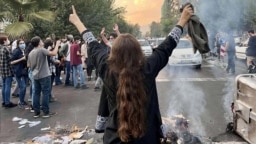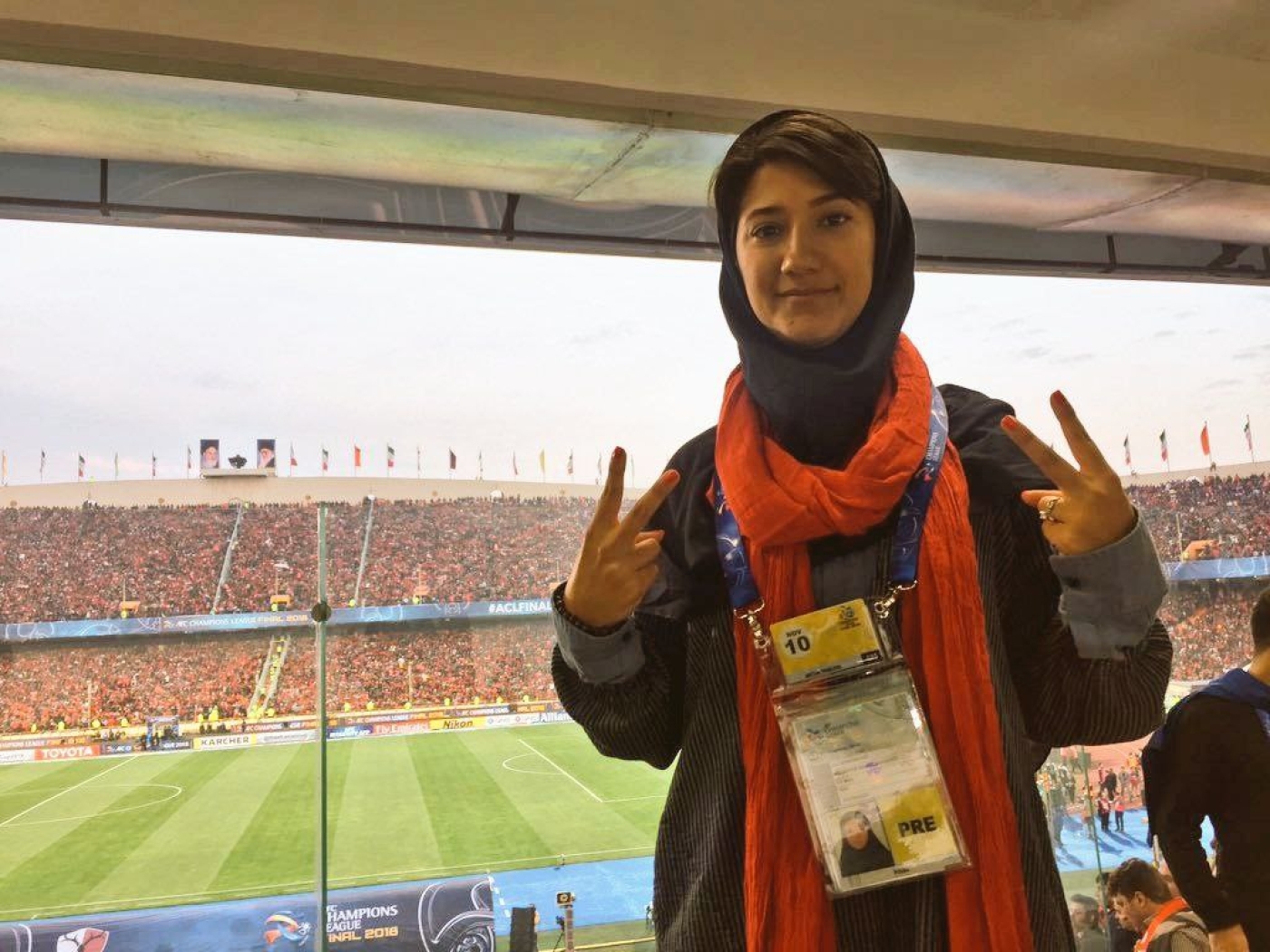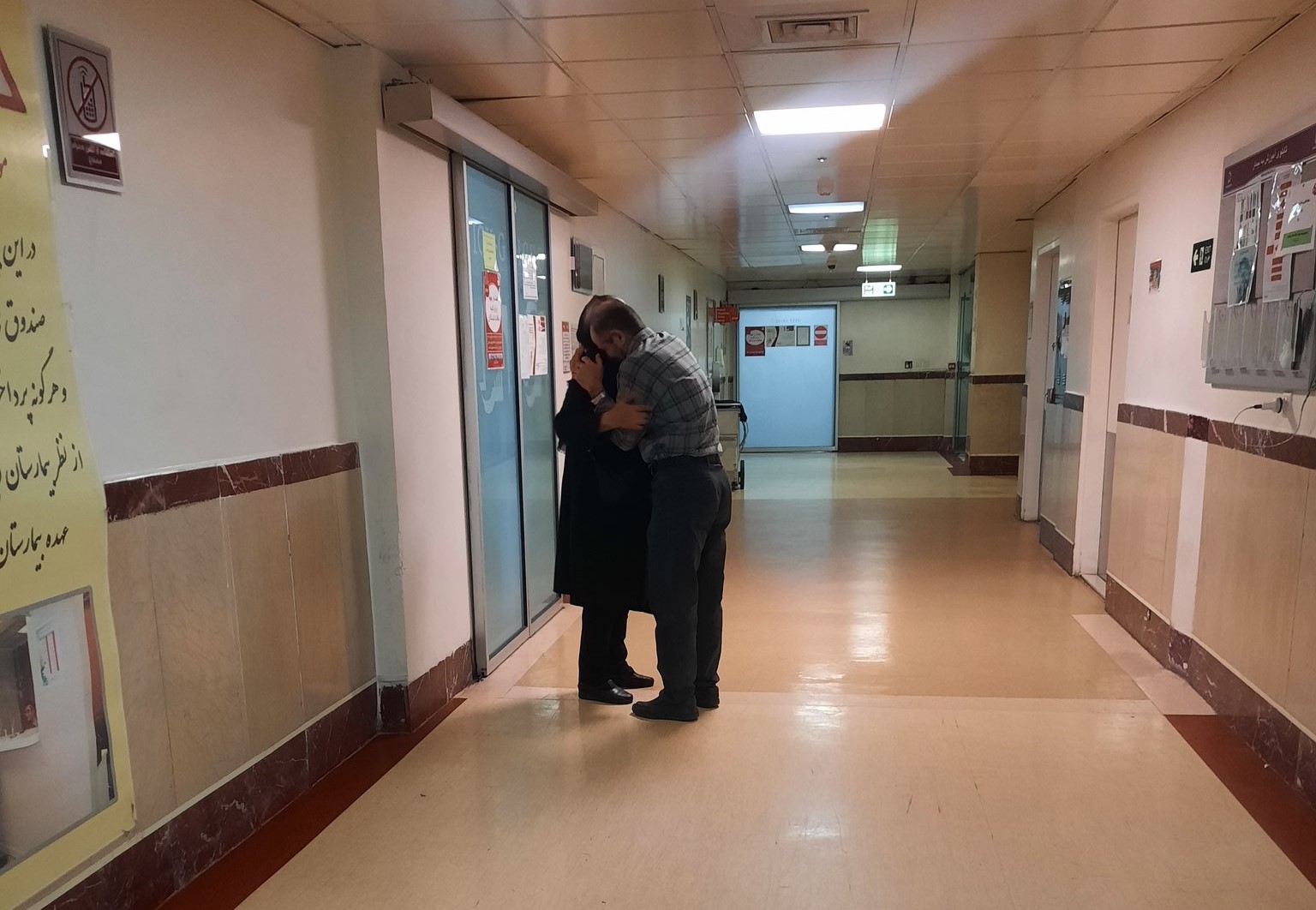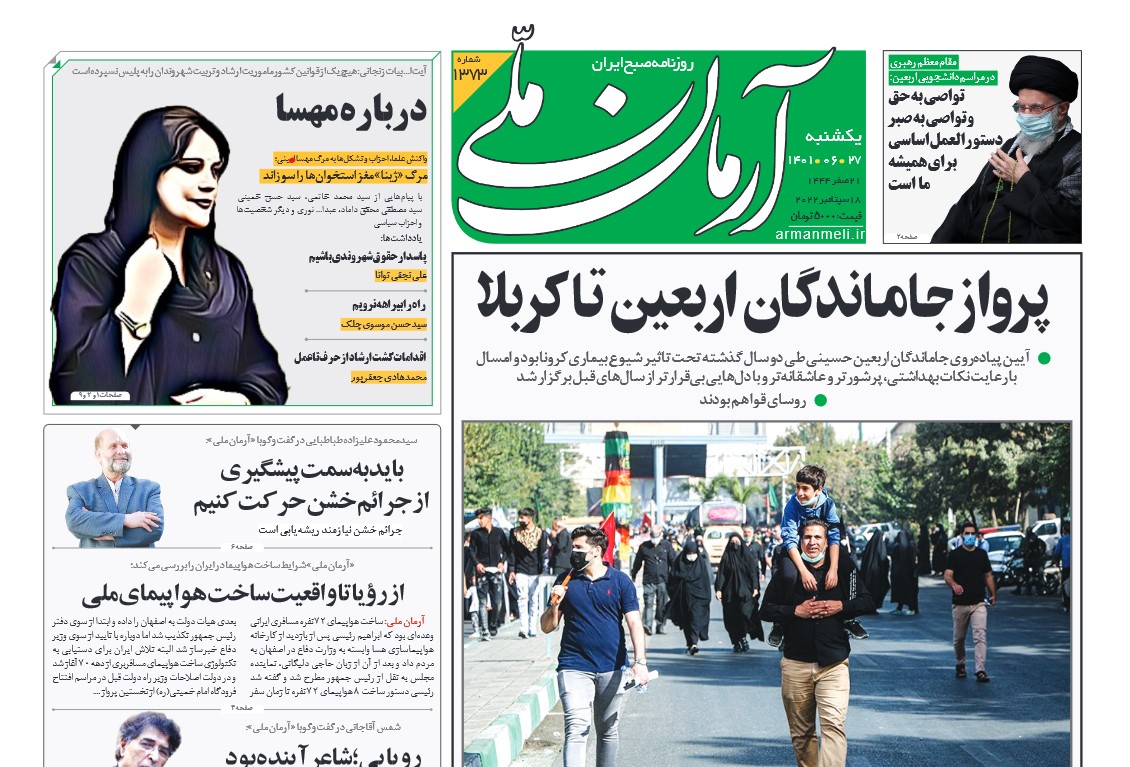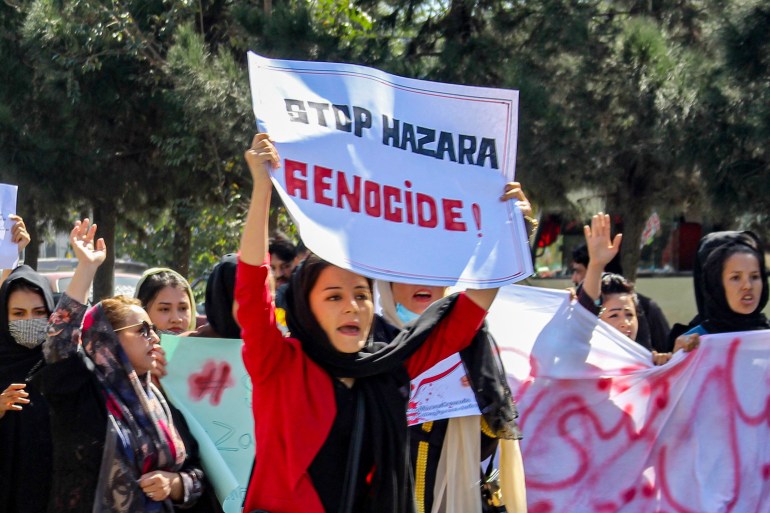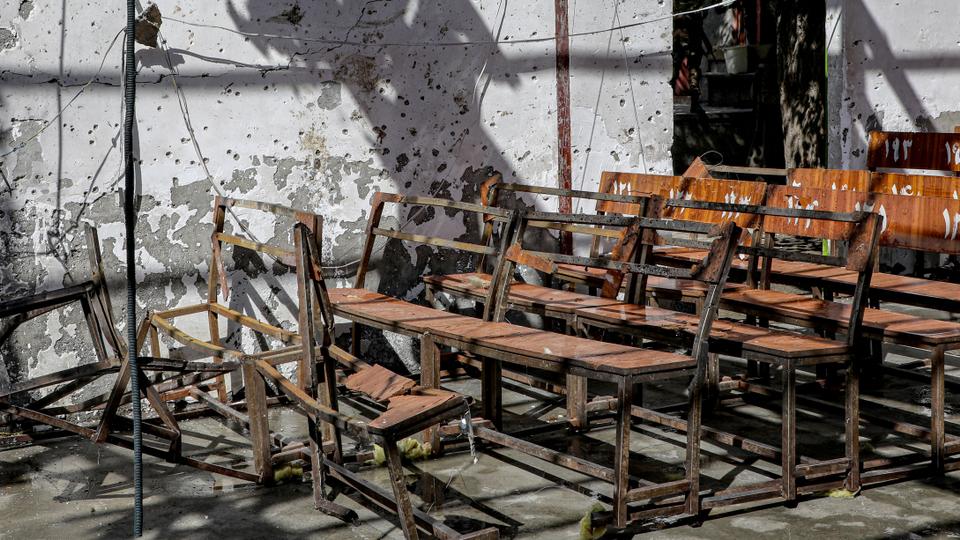Tehran has accused Kurdish armed groups based in Iraq's Kurdistan region of stoking a wave of unrest that has rocked Iran since death of Mahsa Amini
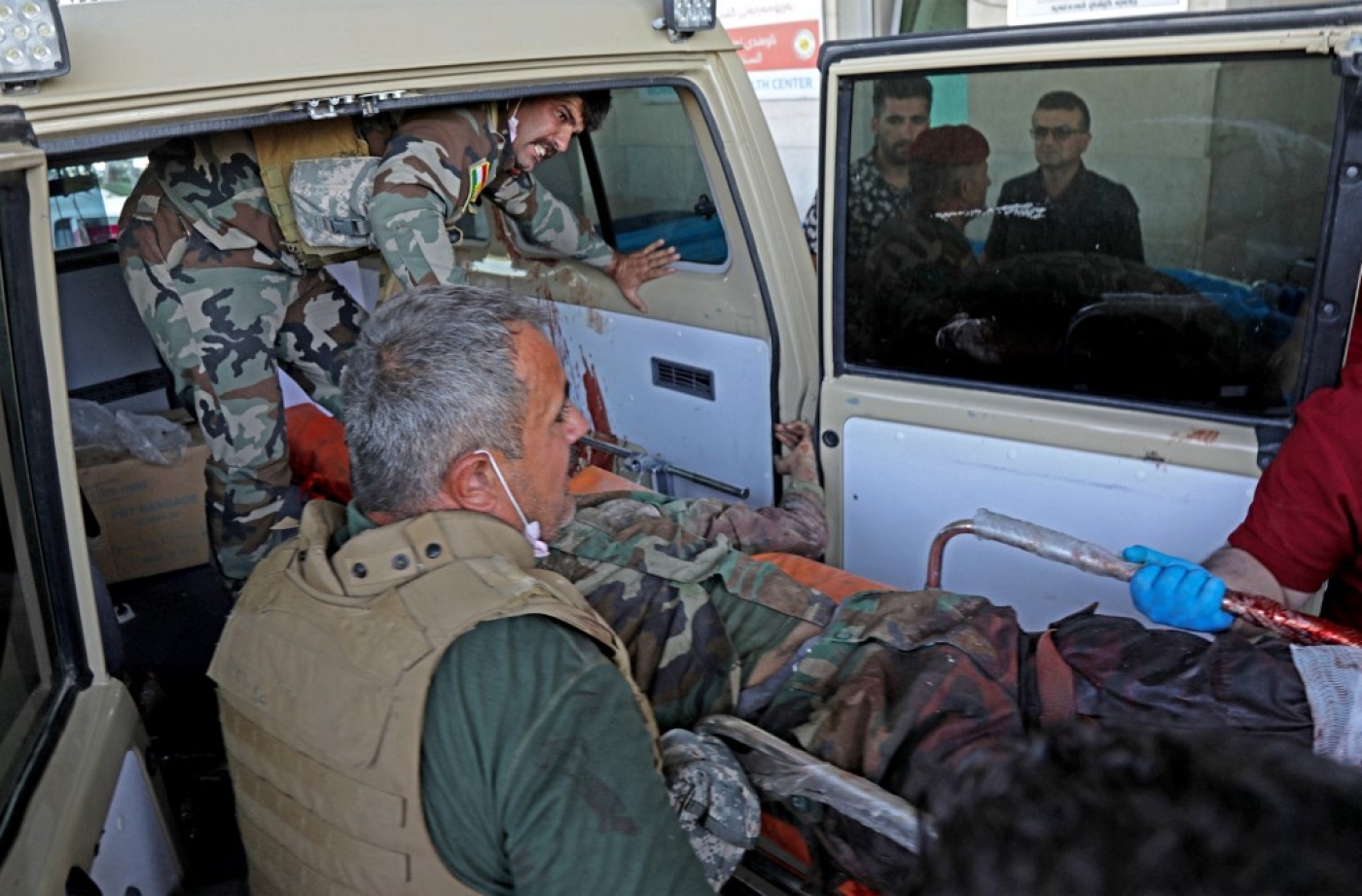
A wounded soldier is taken to hospital following strikes by Iran on the village of Altun Kupri, in Iraq's Kurdistan region, on 28 September 2022 (AFP)
By MEE and agencies
Published date: 1 October 2022
Iran launched artillery and drone strikes on Saturday targeting Kurdish militants in Iraq's north, an Iranian Kurdish official has claimed, days after cross-border attacks killed 14 people.
Tehran has accused Kurdish armed groups based in Iraq's Kurdistan region of stoking a wave of unrest that has rocked the Islamic republic since Mahsa Amini, a Kurd, died in custody last month.
"The Iranian forces launched artillery fire and drone strikes" on bases used by exiled Iranian group Komala in the Mount Halgurd area, near the Iranian border, Atta Nasser, an official from Komala, told AFP.
The strikes "destroyed some outposts, without causing casualties among our ranks", Nasser said.
On Wednesday, a barrage of some 70 missiles and "kamikaze drone" strikes left 14 people dead and 58 wounded, Kurdish officials said. Iraqi Kurdish authorities said most of the casualties were civilians.
In a statement on Thursday, Iran's Islamic Revolutionary Guard Corps (IRGC) said they would press on with attacks on rear bases in neighbouring Iraq until Kurdish rebels had been disarmed.
"We ask the central government and the government of the northern region of Iraq to show more seriousness in their responsibilities towards Iran as a neighbour," it said.
Iran has seen a major wave of protests since the death of Amini, 22, was announced on 16 September after her arrest by the "morality police". A crackdown has left dozens of demonstrators dead.
'Vague incident'
Several Iranian Kurdish groups have been based in northern Iraq's autonomous Kurdistan region for decades.
While combat activities have greatly declined over the years, they continue to mobilise on social media, playing a key role in circulating images of the protests in the aftermath of Amini's death.
'The Iranian state is a target and so any incident is exploited… to incite against this state'- Hassan Nasrallah, Hezbollah
The leader of Lebanon's Hezbollah movement has said that the death of Amini was a "vague incident" that was being exploited against Tehran.
In a speech on Saturday, Hassan Nasrallah said that her death, in circumstances he said remained unclear, was being exploited to incite the protests.
"The Iranian state is a target and so any incident is exploited… to incite against this state," Nasrallah said.
"This vague incident was exploited and people took to the streets," he said.
The Hezbollah chief, a staunch Iran ally, said that the protests rocking the country did not reflect the true will of the Iranian people who he said are loyal to their leadership.
Iran "is stronger than ever and will not be affected", he said.
Iranian Kurds go on strike to protest IRGC attacks on Kurdistan Region

A coordinated strike took place in cities in Iranian Kurdistan on Saturday.

Several cities in Iranian Kurdistan went on strike on Saturday
(Photo: Hengaw).
ERBIL (Kurdistan 24) – A coordinated strike took place in cities in Iranian Kurdistan on Saturday in response to Wednesday's Iranian drone and missile attacks on the Kurdistan Region, which killed at least 14, and injured 60 others.
Kurdish human rights organization Hengaw on Saturday said the widespread took place in 15 cities including Urmia, Oshnovieh, Naqadeh, Bukan, Mahabad, Piranshahr, Rabat, Sardasht, Saqqez, Diwandareh, Mariwan, Sanandaj, Kamiyaran, Rawansar, Shahu, and Ilam.
A Hengaw report said that on Thursday, the Center for the Cooperation of Iranian Kurdistan Parties issued a statement calling on the people of Iranian Kurdistan to go on a general strike on Saturday.
Videos posted by activists show that shop owners in several cities in Iranian Kurdistan closed their shops.
On Wednesday, Iran attacked Kurdish opposition groups with missiles and ‘suicide drones’ into the Kurdistan Region’s Sulaimani and Erbil provinces, killing at least 14, and injuring 60 others.
Mostly civilians were injured during the attack. Also one pregnant woman Reyha Kenani and her child Wanyar died in the Iranian attack.
Furthermore, for the seventh consecutive day Iranian artillery on Saturday bombed a number of border areas inside the Kurdistan Region amidst widespread anti-government protests in Iran over the death of Jina Amini at the hands of Iran's morality police.
ERBIL (Kurdistan 24) – A coordinated strike took place in cities in Iranian Kurdistan on Saturday in response to Wednesday's Iranian drone and missile attacks on the Kurdistan Region, which killed at least 14, and injured 60 others.
Kurdish human rights organization Hengaw on Saturday said the widespread took place in 15 cities including Urmia, Oshnovieh, Naqadeh, Bukan, Mahabad, Piranshahr, Rabat, Sardasht, Saqqez, Diwandareh, Mariwan, Sanandaj, Kamiyaran, Rawansar, Shahu, and Ilam.
A Hengaw report said that on Thursday, the Center for the Cooperation of Iranian Kurdistan Parties issued a statement calling on the people of Iranian Kurdistan to go on a general strike on Saturday.
Videos posted by activists show that shop owners in several cities in Iranian Kurdistan closed their shops.
On Wednesday, Iran attacked Kurdish opposition groups with missiles and ‘suicide drones’ into the Kurdistan Region’s Sulaimani and Erbil provinces, killing at least 14, and injuring 60 others.
Mostly civilians were injured during the attack. Also one pregnant woman Reyha Kenani and her child Wanyar died in the Iranian attack.
Furthermore, for the seventh consecutive day Iranian artillery on Saturday bombed a number of border areas inside the Kurdistan Region amidst widespread anti-government protests in Iran over the death of Jina Amini at the hands of Iran's morality police.
Canada, EU, Belgium strongly condemn IRGC attacks on Kurdistan Region
The EU, Canada and Belgium recently strongly condemns Iran’s missile and drone attacks against the Kurdistan Region.
Wladimir van Wilgenburg

Kurdish school children hide from Iranian attacks near Koya
(Photo: social media).
ERBIL (Kurdistan 24) – Both Canada and the European Union on Friday strongly condemned the Iranian shelling of the Kurdistan Region of Iraq this week.
“The EU condemns in the strongest possible terms the shelling of the Kurdistan Region of Iraq this week, for which Islamic Revolutionary Guards Corps have claimed responsibility,” the statement read.
“Our thoughts are with the victims and their families. These attacks are a violation of Iraq’s sovereignty and territorial integrity. The EU reiterates its full solidarity with the Iraqi people, the Iraqi Government and the Kurdistan Regional Government.”
Moreover, the EU expressed concern about the recent political and security escalation in Iraq amidst the third anniversary of the Oct. 2019 protests in Baghdad.
“Violence is never a solution and must not be allowed to undermine the democratic process,” it said, calling on all parties to work to de-escalation.
Also the Canadian government on Friday “strongly condemns Iran’s missile and drone attacks against the Kurdistan Region of Iraq, which have resulted in multiple civilian deaths and injuries.”
“The Government of Canada extends its condolences to all those affected,” it said.
Moreover, Canada called “on Iran to refrain from attacking its neighbours and to stop undermining peace and stability in the Middle East. These attacks violate Iraq’s sovereignty and territorial integrity, jeopardize civilian lives and do nothing to address the legitimate concerns of the Iranian people.”
“Canada will continue to stand by the Iraqi and Iranian peoples in the face of the Iranian regime’s continued violence and human rights violations.”
Also the Belgian Foreign Ministry in a tweet on Saturday condemned the the Iranian missile attacks in Iraq.
"Our country calls for respect for the sovereignty and territorial integrity of the country and for international law. Our thoughts are with the victims and their loved ones," it said.
As a result of the Iranian strikes, at least 14 people were killed on Wednesday while nearly 60 others were wounded.
The Islamic Revolutionary Guard Corps (IRGC) claimed responsibility and said they would resume strikes unless Iranian Kurdish opposition groups would surrender.
Furthermore, for the eighth consecutive day Iranian artillery on Saturday bombed a number of border areas inside the Kurdistan Region.
Read More: Recent attacks on Kurdistan show ‘repeated pattern of Iranian destabilization’, says UK envoy
Several countries over the past days have condemned the Iranian strikes, including the Netherlands, Belgium, Canada, Poland, Germany, UK, US, Jordan and Egypt.
The EU, Canada and Belgium recently strongly condemns Iran’s missile and drone attacks against the Kurdistan Region.
Wladimir van Wilgenburg

Kurdish school children hide from Iranian attacks near Koya
(Photo: social media).
ERBIL (Kurdistan 24) – Both Canada and the European Union on Friday strongly condemned the Iranian shelling of the Kurdistan Region of Iraq this week.
“The EU condemns in the strongest possible terms the shelling of the Kurdistan Region of Iraq this week, for which Islamic Revolutionary Guards Corps have claimed responsibility,” the statement read.
“Our thoughts are with the victims and their families. These attacks are a violation of Iraq’s sovereignty and territorial integrity. The EU reiterates its full solidarity with the Iraqi people, the Iraqi Government and the Kurdistan Regional Government.”
Moreover, the EU expressed concern about the recent political and security escalation in Iraq amidst the third anniversary of the Oct. 2019 protests in Baghdad.
“Violence is never a solution and must not be allowed to undermine the democratic process,” it said, calling on all parties to work to de-escalation.
Also the Canadian government on Friday “strongly condemns Iran’s missile and drone attacks against the Kurdistan Region of Iraq, which have resulted in multiple civilian deaths and injuries.”
“The Government of Canada extends its condolences to all those affected,” it said.
Moreover, Canada called “on Iran to refrain from attacking its neighbours and to stop undermining peace and stability in the Middle East. These attacks violate Iraq’s sovereignty and territorial integrity, jeopardize civilian lives and do nothing to address the legitimate concerns of the Iranian people.”
“Canada will continue to stand by the Iraqi and Iranian peoples in the face of the Iranian regime’s continued violence and human rights violations.”
Also the Belgian Foreign Ministry in a tweet on Saturday condemned the the Iranian missile attacks in Iraq.
"Our country calls for respect for the sovereignty and territorial integrity of the country and for international law. Our thoughts are with the victims and their loved ones," it said.
As a result of the Iranian strikes, at least 14 people were killed on Wednesday while nearly 60 others were wounded.
The Islamic Revolutionary Guard Corps (IRGC) claimed responsibility and said they would resume strikes unless Iranian Kurdish opposition groups would surrender.
Furthermore, for the eighth consecutive day Iranian artillery on Saturday bombed a number of border areas inside the Kurdistan Region.
Read More: Recent attacks on Kurdistan show ‘repeated pattern of Iranian destabilization’, says UK envoy
Several countries over the past days have condemned the Iranian strikes, including the Netherlands, Belgium, Canada, Poland, Germany, UK, US, Jordan and Egypt.
UNCHR says civilians lives “must be
protected” after Iranian attack“
We are extremely shocked and concerned that the
attack has impacted refugee families."
ERBIL (Kurdistan 24) – Shaza Shekfeh, a media officer of the United Nations Refugee Agency, known as UNHCR, told Kurdistan 24 on Thursday that the Iranian attack on Kurdish opposition parties in Koya affected refugees living in the vicinity.
“The Kurdistan Regional Government is leading the response to support those who are impacted by yesterday's attack and according to the Department of Health in Koya, regrettably the attack resulted in nine casualties and 28 people were injured,” she said.
According to later data, at least 14 people were killed by the Iranian missile and drone attacks on Wednesday while nearly 60 others were wounded. Also one pregnant woman Reyha Kenani and her child Wanyar died in the Iranian attack near Koya.
The Iranian attacks come amidst widespread protests in Iran over the death of Zhina Amini at the hands of the morality police in mid September.
“We are extremely shocked and concerned that the attack has impacted refugee families. It also impacted a school where refugee students were present. Civilian lives must be protected at all times, including the refugees and especially the children," Shaza Shekfeh underlined.
"The UNHCR is in close dialogue with the authorities concerning the immediate needs of the most affected,” she added.
Koya hosts around 500 refugee families who fled Iran. The UNCHR in a statement on Wednesday also underlined UNHCR “is gravely concerned about today’s attack, which impacted the Iranian refugee settlements in Koya, the Kurdistan Region of Iraq.”
Read More: UN Refugee Agency says Iranian attacks affected refugees in Koya
"The attack is reported to have resulted in a number of civilian casualties and injuries, including Iranian refugees – among them are women and children. "UNHCR extends our deepest condolences to all those affected."
Moreover, the UNCHR confirms the attack "reportedly impacted a primary school where refugee students were present."
“We have started engaging with authorities in dialogue since yesterday. Our partners on the ground are providing psychosocial support to traumatized families, especially children who are in school at the moment,” Shekfeh said.
Moreover, she said “refugee outreach volunteers are showing strength and resilience by supporting their communities as well and offering comfort and psychosocial support.”
“I'd like to extend our appreciation for the work the outreach volunteers are doing on the ground despite these difficult circumstances.”
However, she underlined that the Kurdistan Regional Government (KRG) is leading the humanitarian response to the attack. “And of course, UNHCR is closely engaging in dialogue how to better respond to those who are mostly impacted.”
She also said that the UNHCR has been supporting Kurdish refugees from Iran in Koya with cash assistance with the winter assistance, registration and education services. “They were also receiving health benefits from the public institutions that are available”
She said in line with the ‘one refugee approach, ‘the Iranian refugees in these settlements were receiving the same services as any refugee in the Kurdistan region of Iraq.”
“The Kurdistan Regional Government is leading the response to support those who are impacted by yesterday's attack and according to the Department of Health in Koya, regrettably the attack resulted in nine casualties and 28 people were injured,” she said.
According to later data, at least 14 people were killed by the Iranian missile and drone attacks on Wednesday while nearly 60 others were wounded. Also one pregnant woman Reyha Kenani and her child Wanyar died in the Iranian attack near Koya.
The Iranian attacks come amidst widespread protests in Iran over the death of Zhina Amini at the hands of the morality police in mid September.
“We are extremely shocked and concerned that the attack has impacted refugee families. It also impacted a school where refugee students were present. Civilian lives must be protected at all times, including the refugees and especially the children," Shaza Shekfeh underlined.
"The UNHCR is in close dialogue with the authorities concerning the immediate needs of the most affected,” she added.
Koya hosts around 500 refugee families who fled Iran. The UNCHR in a statement on Wednesday also underlined UNHCR “is gravely concerned about today’s attack, which impacted the Iranian refugee settlements in Koya, the Kurdistan Region of Iraq.”
Read More: UN Refugee Agency says Iranian attacks affected refugees in Koya
"The attack is reported to have resulted in a number of civilian casualties and injuries, including Iranian refugees – among them are women and children. "UNHCR extends our deepest condolences to all those affected."
Moreover, the UNCHR confirms the attack "reportedly impacted a primary school where refugee students were present."
“We have started engaging with authorities in dialogue since yesterday. Our partners on the ground are providing psychosocial support to traumatized families, especially children who are in school at the moment,” Shekfeh said.
Moreover, she said “refugee outreach volunteers are showing strength and resilience by supporting their communities as well and offering comfort and psychosocial support.”
“I'd like to extend our appreciation for the work the outreach volunteers are doing on the ground despite these difficult circumstances.”
However, she underlined that the Kurdistan Regional Government (KRG) is leading the humanitarian response to the attack. “And of course, UNHCR is closely engaging in dialogue how to better respond to those who are mostly impacted.”
She also said that the UNHCR has been supporting Kurdish refugees from Iran in Koya with cash assistance with the winter assistance, registration and education services. “They were also receiving health benefits from the public institutions that are available”
She said in line with the ‘one refugee approach, ‘the Iranian refugees in these settlements were receiving the same services as any refugee in the Kurdistan region of Iraq.”
Egypt condemns Iranian attack on
Kurdistan region of Iraq
September 30, 2022

Smoke rises over the headquarters following an attack in the Koy Sanjaq district of Erbil, Iraq on September 28, 2022.
[Ahsan Mohammed Ahmed Ahmed - Anadolu Agency]
September 30, 2022 at 5:56 pm
The Egyptian Foreign Ministry has condemned the Iranian bombing of areas in the Kurdistan region of Iraq, describing it as a "blatant violation of Iraq's sovereignty and security".
In a press statement made available to the Russia Today Arabic news website, the Ministry denounced Iran's attacks on areas in the Kurdistan region of Iraq, which resulted in the death of "innocent civilians".
Egypt "has been monitoring the tensions in the region over the past few days, and warns of their repercussions on the stability of the region and the safety of its people," the statement read.
Egypt further expressed its "sincere condolences to the government and people" of Iraq for the victims of this attack, and it wished a speedy recovery to the injured.
September 30, 2022 at 5:56 pm
The Egyptian Foreign Ministry has condemned the Iranian bombing of areas in the Kurdistan region of Iraq, describing it as a "blatant violation of Iraq's sovereignty and security".
In a press statement made available to the Russia Today Arabic news website, the Ministry denounced Iran's attacks on areas in the Kurdistan region of Iraq, which resulted in the death of "innocent civilians".
Egypt "has been monitoring the tensions in the region over the past few days, and warns of their repercussions on the stability of the region and the safety of its people," the statement read.
Egypt further expressed its "sincere condolences to the government and people" of Iraq for the victims of this attack, and it wished a speedy recovery to the injured.


